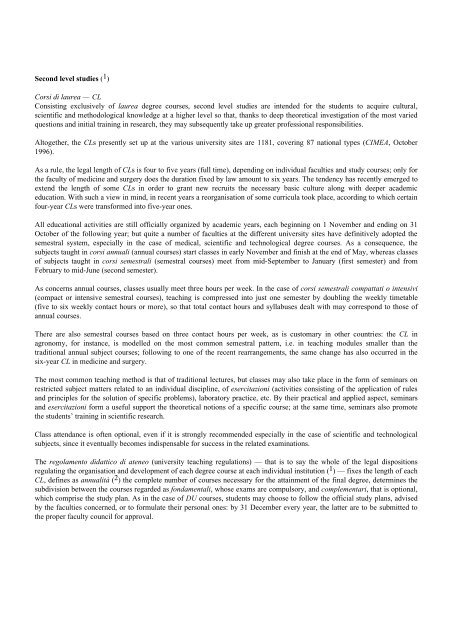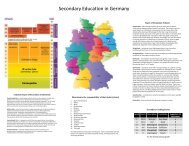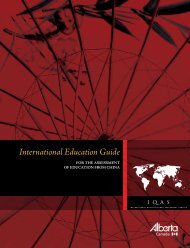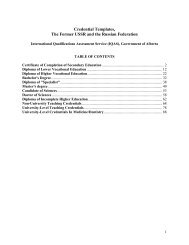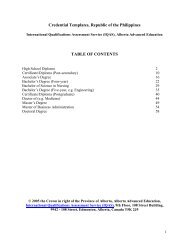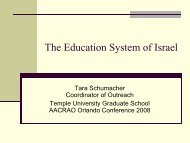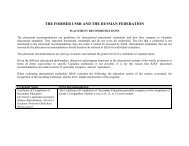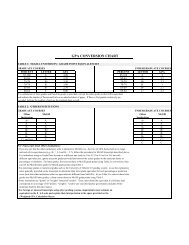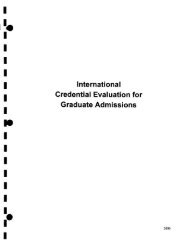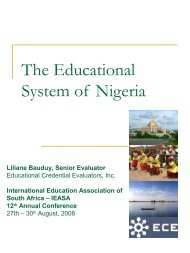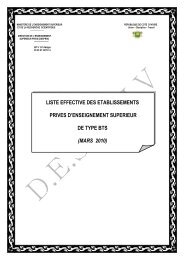NARIC guide on Higher Education Systems in the European Union
NARIC guide on Higher Education Systems in the European Union
NARIC guide on Higher Education Systems in the European Union
Create successful ePaper yourself
Turn your PDF publications into a flip-book with our unique Google optimized e-Paper software.
Sec<strong>on</strong>d level studies ( 1 )<br />
Corsi di laurea — CL<br />
C<strong>on</strong>sist<strong>in</strong>g exclusively of laurea degree courses, sec<strong>on</strong>d level studies are <strong>in</strong>tended for <strong>the</strong> students to acquire cultural,<br />
scientific and methodological knowledge at a higher level so that, thanks to deep <strong>the</strong>oretical <strong>in</strong>vestigati<strong>on</strong> of <strong>the</strong> most varied<br />
questi<strong>on</strong>s and <strong>in</strong>itial tra<strong>in</strong><strong>in</strong>g <strong>in</strong> research, <strong>the</strong>y may subsequently take up greater professi<strong>on</strong>al resp<strong>on</strong>sibilities.<br />
Altoge<strong>the</strong>r, <strong>the</strong> CLs presently set up at <strong>the</strong> various university sites are 1181, cover<strong>in</strong>g 87 nati<strong>on</strong>al types (CIMEA, October<br />
1996).<br />
As a rule, <strong>the</strong> legal length of CLs is four to five years (full time), depend<strong>in</strong>g <strong>on</strong> <strong>in</strong>dividual faculties and study courses; <strong>on</strong>ly for<br />
<strong>the</strong> faculty of medic<strong>in</strong>e and surgery does <strong>the</strong> durati<strong>on</strong> fixed by law amount to six years. The tendency has recently emerged to<br />
extend <strong>the</strong> length of some CLs <strong>in</strong> order to grant new recruits <strong>the</strong> necessary basic culture al<strong>on</strong>g with deeper academic<br />
educati<strong>on</strong>. With such a view <strong>in</strong> m<strong>in</strong>d, <strong>in</strong> recent years a reorganisati<strong>on</strong> of some curricula took place, accord<strong>in</strong>g to which certa<strong>in</strong><br />
four-year CLs were transformed <strong>in</strong>to five-year <strong>on</strong>es.<br />
All educati<strong>on</strong>al activities are still officially organized by academic years, each beg<strong>in</strong>n<strong>in</strong>g <strong>on</strong> 1 November and end<strong>in</strong>g <strong>on</strong> 31<br />
October of <strong>the</strong> follow<strong>in</strong>g year; but quite a number of faculties at <strong>the</strong> different university sites have def<strong>in</strong>itively adopted <strong>the</strong><br />
semestral system, especially <strong>in</strong> <strong>the</strong> case of medical, scientific and technological degree courses. As a c<strong>on</strong>sequence, <strong>the</strong><br />
subjects taught <strong>in</strong> corsi annuali (annual courses) start classes <strong>in</strong> early November and f<strong>in</strong>ish at <strong>the</strong> end of May, whereas classes<br />
of subjects taught <strong>in</strong> corsi semestrali (semestral courses) meet from mid-September to January (first semester) and from<br />
February to mid-June (sec<strong>on</strong>d semester).<br />
As c<strong>on</strong>cerns annual courses, classes usually meet three hours per week. In <strong>the</strong> case of corsi semestrali compattati o <strong>in</strong>tensivi<br />
(compact or <strong>in</strong>tensive semestral courses), teach<strong>in</strong>g is compressed <strong>in</strong>to just <strong>on</strong>e semester by doubl<strong>in</strong>g <strong>the</strong> weekly timetable<br />
(five to six weekly c<strong>on</strong>tact hours or more), so that total c<strong>on</strong>tact hours and syllabuses dealt with may corresp<strong>on</strong>d to those of<br />
annual courses.<br />
There are also semestral courses based <strong>on</strong> three c<strong>on</strong>tact hours per week, as is customary <strong>in</strong> o<strong>the</strong>r countries: <strong>the</strong> CL <strong>in</strong><br />
agr<strong>on</strong>omy, for <strong>in</strong>stance, is modelled <strong>on</strong> <strong>the</strong> most comm<strong>on</strong> semestral pattern, i.e. <strong>in</strong> teach<strong>in</strong>g modules smaller than <strong>the</strong><br />
traditi<strong>on</strong>al annual subject courses; follow<strong>in</strong>g to <strong>on</strong>e of <strong>the</strong> recent rearrangements, <strong>the</strong> same change has also occurred <strong>in</strong> <strong>the</strong><br />
six-year CL <strong>in</strong> medic<strong>in</strong>e and surgery.<br />
The most comm<strong>on</strong> teach<strong>in</strong>g method is that of traditi<strong>on</strong>al lectures, but classes may also take place <strong>in</strong> <strong>the</strong> form of sem<strong>in</strong>ars <strong>on</strong><br />
restricted subject matters related to an <strong>in</strong>dividual discipl<strong>in</strong>e, of esercitazi<strong>on</strong>i (activities c<strong>on</strong>sist<strong>in</strong>g of <strong>the</strong> applicati<strong>on</strong> of rules<br />
and pr<strong>in</strong>ciples for <strong>the</strong> soluti<strong>on</strong> of specific problems), laboratory practice, etc. By <strong>the</strong>ir practical and applied aspect, sem<strong>in</strong>ars<br />
and esercitazi<strong>on</strong>i form a useful support <strong>the</strong> <strong>the</strong>oretical noti<strong>on</strong>s of a specific course; at <strong>the</strong> same time, sem<strong>in</strong>ars also promote<br />
<strong>the</strong> students’ tra<strong>in</strong><strong>in</strong>g <strong>in</strong> scientific research.<br />
Class attendance is often opti<strong>on</strong>al, even if it is str<strong>on</strong>gly recommended especially <strong>in</strong> <strong>the</strong> case of scientific and technological<br />
subjects, s<strong>in</strong>ce it eventually becomes <strong>in</strong>dispensable for success <strong>in</strong> <strong>the</strong> related exam<strong>in</strong>ati<strong>on</strong>s.<br />
The regolamento didattico di ateneo (university teach<strong>in</strong>g regulati<strong>on</strong>s) — that is to say <strong>the</strong> whole of <strong>the</strong> legal dispositi<strong>on</strong>s<br />
regulat<strong>in</strong>g <strong>the</strong> organisati<strong>on</strong> and development of each degree course at each <strong>in</strong>dividual <strong>in</strong>stituti<strong>on</strong> ( 1 ) — fixes <strong>the</strong> length of each<br />
CL, def<strong>in</strong>es as annualità ( 2 ) <strong>the</strong> complete number of courses necessary for <strong>the</strong> atta<strong>in</strong>ment of <strong>the</strong> f<strong>in</strong>al degree, determ<strong>in</strong>es <strong>the</strong><br />
subdivisi<strong>on</strong> between <strong>the</strong> courses regarded as f<strong>on</strong>damentali, whose exams are compulsory, and complementari, that is opti<strong>on</strong>al,<br />
which comprise <strong>the</strong> study plan. As <strong>in</strong> <strong>the</strong> case of DU courses, students may choose to follow <strong>the</strong> official study plans, advised<br />
by <strong>the</strong> faculties c<strong>on</strong>cerned, or to formulate <strong>the</strong>ir pers<strong>on</strong>al <strong>on</strong>es: by 31 December every year, <strong>the</strong> latter are to be submitted to<br />
<strong>the</strong> proper faculty council for approval.


